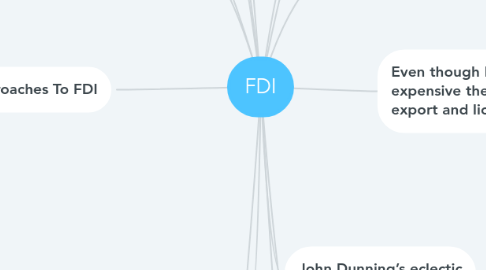
1. Flow of FDI : The amount of FDI undertaken over a period of time (year)
2. Stock of FDI: Total accumulated value of foreign owned assets at a given time
3. Inflows of FDI: The flow of FDI into a country
4. Growth of FDI
4.1. 1. To bypass trade barriers
4.2. 2. Political and economic changes: Deregulation, privatization, fewer restrictions on FDI
4.3. 3. New bilateral investment treaties: Designed to facilitate investment
4.4. 4. Globalisation of the world economy
5. Knickerbocker’s theory: FDI flows are a reflection of strategic rivalry between firms in the global marketplace
5.1. Oligopoly: few companies dominate a market
5.2. Multipoint competition :when two or more enterprises encounter each other in different regional markets, national markets, or industries
5.3. limitation: fails to give a concise reason why the first firm makes a move before the others:
6. Theoretical approaches To FDI
6.1. 1.The radical view: MNE is an instrument of imperialist domination and a tool for exploiting host countries
6.2. 2.The free market view :international production should be distributed among countries according to the theory of comparative advantage
6.3. 3. Pragmatic nationalism: FDI has both benefits
7. Main benefits and costs of FDI to the home country
7.1. benefits of FDI to the home country
7.1.1. 1. the inward flow of foreign earnings
7.1.2. 2. The employments effects
7.1.3. 3. The gains from learning valuable skills from foreign markets
7.2. Costs of FDI to the home country
7.2.1. 1. balance of payments can suffer
7.2.2. 2.Employment may also be negatively affected if the FDI is a substitute for domestic production
8. Regional economic integration
8.1. Agreements between countries in a geographic region to reduce tariff and non-tariff barriers to the free flow of goods, services, and factors of production between each other
8.2. 1.Free Trade Area:eliminates all barriers to the trade of goods and services among members Eg: NAFTA
8.3. 2.Customs Union: eliminates trade barriers between members and adopts a common external trade policy
8.3.1. MERCOSUR,CACM,CARICOM
8.4. 3. Common Market:has no trade barriers between members, a common external trade policy, and the free movement of the factors of production
8.5. 4. Economic Union:
8.6. 5.Political Union
8.7. Economic integration
8.7.1. EU
8.7.1.1. Product of two political factors:1.Desire for lasting peace after 2 world wars 2. Hold their b world's political and economic stage
8.7.1.2. MAIN INSTITUTIONS OF THE EU
8.7.1.2.1. European Council
8.7.1.2.2. European Parliament
8.7.1.2.3. European Commission
8.7.1.2.4. Court of Justice
8.7.2. North American Free Trade Area (NAFTA)
8.7.2.1. trilateral free-trade deal between the United States, Canada, and Mexico came into force in January 1994
8.7.3. Association of Southeast Asian Nations (ASEAN)
8.7.3.1. foster freer trade between member countries and to achieve some cooperation in their industrial policies
8.7.4. Asia-Pacific Economic Cooperation (APEC)
8.7.4.1. Currently has 21 members including such economic powerhouses as the United States, Japan, and China.
8.7.5. Pros and Cons Regional economic integration
8.7.5.1. opens new markets
8.7.5.2. allows firms to realize cost economies
8.7.5.3. However, within each grouping, the business environment becomes competitive
8.7.5.4. there is a risk of being shut out of the single market by the creation of a “trade fortress”
9. Def: Firm directly invests in facilities to produce product and service in a foreign market
10. Two forms : greenfield investment and acquisition/ merging
10.1. Greenfield: establishment of a new operation in a foreign country
10.2. Merge/ Acquisition: Minority Majority or Fulltakeover
10.3. Why Acquisition over greenfield investment?
10.3.1. 1. easier and less risky
10.3.2. 2. increase the efficiency
10.3.3. 3. quicker to execute
11. Outflows of FDI : flow of FDI out of a country
12. Even though FDI is risky and expensive there are benefits over export and licensing
12.1. Exports :Transportation costs Trade barriers Import tariffs or quotas
12.2. Licensing:Giving away valuable technological know-how to a potential competitor Does not give a firm the control over manufacturing, marketing, and strategy in the foreign country This is where a Firm’s competitive advantage is based on
12.2.1. Market Imperfections approach
13. John Dunning’s eclectic paradigm
13.1. Location-specific advantages: resource endowments or assets, tied to a particular location which a firm finds valuable to combine with its own unique assets
13.2. Externalities - knowledge spillovers that occur when companies in the same industry locate in the same area
14. Main benefits and costs of FDI to the host country
14.1. Four main benefits of inward FDI for a host country:
14.1.1. 1. Resource transfer effects
14.1.2. 2. Employment effects
14.1.3. 3. Balance of payments effects FDI can help country to achieve a current account surplus
14.1.4. 4. Effects on competition and economic growth: driving down prices and improving the welfare of consumers
14.2. FDI has three main costs
14.2.1. 1. Adverse effects of FDI on competition: MNEs may have greater economic power than indigenous competitors
14.2.2. 2. Perceived loss of national sovereignty and autonomy
14.2.3. 3. Adverse effects on the balance of payments
